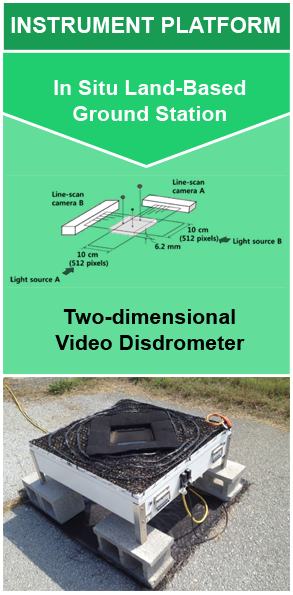Instrument: 2DVD Disdrometer
A disdrometer is an optical device situated on a stationary ground station platform that measures properties of different hydrometeor (precipitation) types such as raindrops, snowflakes, and hail. The Two-Dimensional Video Disdrometer (2DVD) uses two high speed line scan cameras to provide continuous measurements of size distribution, shape, and fall velocities of all precipitation particles and types.
Two light planes, provided by two internal lamps, cut across the approximate 10x10 cm virtual measurement area and are projected onto two high speed line-scan cameras. Hydrometeors that fall through the light planes cast a shadow that is recorded by the two cameras nested within the instrument. The light planes are separated by a calibrated distance between which the velocity of a falling particle can be measured. The line scan cameras sample each plane every 18 microseconds; therefore, as a hydrometeor falls through the measurement area, several line scans of each image are recorded from two sides and two different heights allowing precise measurements to be made.
Data obtained includes drop-size-distribution, rain rate, fall velocity, precipitation type, droplet size. The 2DVD instrument has measuring limitations, such as the instrument able to measure drops within a certain size or within a certain velocity.
The accuracy of these measurements can be affected by insects, splashing water droplets and multiple droplets falling between the cameras at once which are accounted for through quality control measures. When a 2DVD disdrometer fails to collect 20% or more of the measurements from an event, the data collected is considered invalid.

| SPATIAL RESOLUTION | SPATIAL EXTENT | TEMPORAL RESOLUTION | ACCURACY OF RAIN RATE MEASUREMENTS | SAMPLING DURATION/DWELL TIME |
|---|---|---|---|---|
| 200 micrometer | point | Per rain event | ±0.45 mm | 18 microseconds |
Grazioli, J., D. Tuia, S. Monhart, M. Schneebeli, T. Raupach, and A. Berne (2014): Hydrometeor classification from two-dimensional video disdrometer data. Atmospheric Measurement Techniques, 7, 2869-2882. doi: https://doi.org/10.5194/amt-7-2869-2014
Jaffrain, J., A. Studzinski, and A. Berne (2011): A network of disdrometers to quantify the small-scale variability of the raindrop size distribution. Water Resour. Res., 47, W00H06, doi: http://dx.doi.org/10.1029/2010WR009872
Kathiravelu, Gopinath, Terry Lucke, and Peter Nichols (2016): Rain Drop Measurement Techniques: A Review. Water, 8 (29), 1-20. doi: https://doi.org/10.3390/w8010029
Kruger, A. and W. F. Krajewski (2002): Two-Dimensional Video Disdrometer: A Description, Journal of Atmospheric and Oceanic Technology, 19, 602-617. doi: https://doi.org/10.1175/1520-0426(2002)019%3C0602:TDVDAD%3E2.0.CO;2
Schönhuber, M., G. Lammer, and W. L. Randeu (2008): The 2D-video-disdrometer, Precipitation: Advances in Measurement, Estimation and Prediction. S. Michaelides, Ed., Springer, 3-31. doi: https://doi.org/10.1007/978-3-540-77655-0_1
Tokay, A., A. Kruger, and W. Krajewski (2001): Comparison of drop size distribution measurements by impact and optical disdrometers. J. Appl. Meteor., 40, 2083–2097. doi: https://doi.org/10.1175/1520-0450(2001)040%3C2083:CODSDM%3E2.0.CO;2









